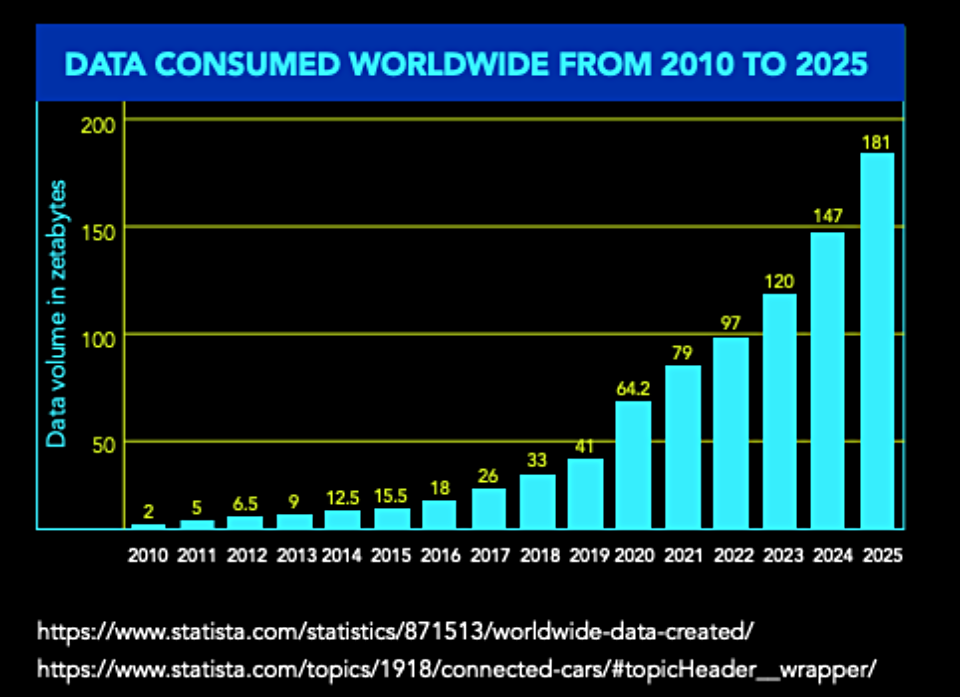In the not-so-distant past, physician prescribing data was essentially a commodity with limited breadth or depth for the purposes of drug development and commercialization. Two primary third-party providers aggregated data from essentially the same sources.
As a result, the data available for biopharma business decision-making could be dropped into an Excel spreadsheet, manipulated as needed, and mined for high-level insights. It was all “rearview mirror” knowledge, providing limited guidance in making real-time decisions.
Those days are over (to put it mildly).
The world of “knowledge” has exploded in the last decade (see graph below). Everything is now digitized: prescription information, medical visits/procedures, lab test results, doctors’ notes, how physician specialties work together to treat the same patient… even a patient’s consumer behavior. All of this is available as it happens, providing an immediate and holistic view of patient-healthcare system interactions.

That’s good news, of course. More data means an increased ability to understand the patient journey deeply and to take previously impossible actions, such as deploying patient support at the first sign they might discontinue treatment or educating an HCP on the value of a treatment just before an eligible patient enters their office.
But it’s not all upside. These changes represent a minefield that, if not carefully contemplated and proactively managed, can consume precious people and financial resources while yielding marginal benefits (sometimes even introducing unexpected compliance risks to the organization).
Big Data, Precise Insights
As the volume, variety, and velocity of data capture have grown exponentially, so has the focus on developing therapies for niche patient populations and rare diseases. This increases the pressure on traditional commercial analytics methods, which struggle to deliver timely/relevant insights on smaller, less heterogeneous populations.
For example, we can now identify and isolate specific groups of people — as few as several hundred out of an entire data set of 300+ million — who share similar characteristics and experiences regarding their diagnosis and treatment journey. This allows us to provide the right therapy to the right patient at the right time — words we have always said but can now act on precisely.
Provided… we can tap into this “dataverse” in a relevant, digestible, and efficient way — a task that can be both overwhelming and expensive.
For all this data to be useful, it must be procured from validated sources, stored in a secure location, integrated with internal company data, manipulated, analyzed, and understood. Plus, it must be immediately available — in or near real-time — for significant portions of the population. Only then can it be utilized to inform decisions.
Unfortunately, traditional warehousing, analytics tools (e.g., Excel), and (often) staff are not up to the task. Organizations are drowning in information but technically unable to deeply understand the state of their business or the patients they serve. They are bombarded by claims that all they need is to buy a specific data set or use the latest and greatest analytics approach, only to be disappointed in the value of what they get.
That’s why data and its associated analytics should be considered a strategy rather than simply a tactic. With the right market data strategy, we can apply data insights to enable and accelerate the goals of many functions across the organization, from drug discovery and clinical development to medical affairs, manufacturing, and commercial.
Developing a Corporate Data Strategy
A corporate market data strategy is fundamental to the success of the company and its assets. It serves as a long-range vision for the time, effort, and investment in the internal or external data required. It’s a foundational framework that guides the data collection, storage, integration, cleansing, and utilization to answer the questions needed to achieve the company’s business aspirations.
In practice, it should incorporate a holistic, cross-functional view of the organization’s overarching business objectives, working backward to understand what information, market understanding, patient journey, healthcare provider, and payer insights are needed to guide the business over the goal line. In fact, careful strategic planning around using a variety of data can identify innovative functional strategies and tactics previously unimaginable.
In addition, by helping the company leverage multiple different data assets (both internally generated and externally purchased) and keep pace with rapidly changing technology advancements, a corporate data strategy also serves to mitigate risks associated with regulatory requirements and the handling of data.
Start Now, Not Just Prior to a Product Launch
It doesn’t need to be implemented all at once, but by developing a strategy early, the team is able to define the types of data required and build a roadmap that enables efficient and proactive anticipation, plus navigation of any challenges throughout the commercialization journey.
Here are a few key steps to get started…
- Commit to an analytics-driven culture that continually looks for new ways to leverage data as the company grows. This is not a “one-and-done” situation.
- Work as a team. “Blue sky” brainstorm with your team the questions that, if answered, would improve organizational decision-making and impact patient health.
- Seek experienced counsel. Engage a trusted thought partner who has done it before, internally or externally.
Conclusion
Once upon a time, data was simple and mainly used to measure what had already happened. Today, in order to best serve the patients, we must anticipate when help will be needed and where they will go to get it.
This won’t happen by force-fitting antiquated commercial analytics approaches and tools — they are simply incapable of keeping pace with the speed, volume, and complexity of today’s data.
A simple and manageable starting point is to create a corporate data strategy and a step-by-step plan for your organization to develop and enhance its data management and analytics capabilities.